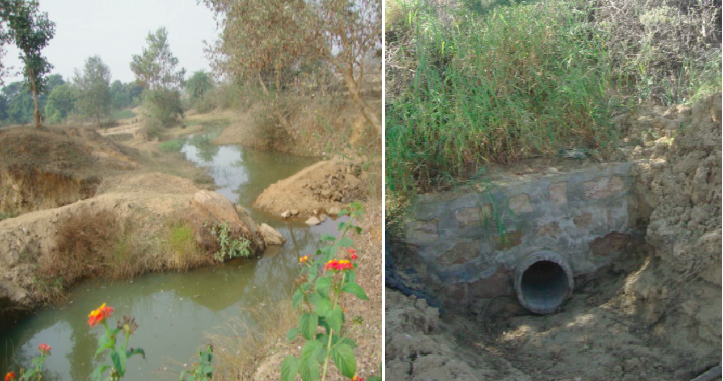In most parts of India, water-harvesters in various forms have been the norm. The most elaborate of these have been the step-wells, generally referred to locally as the baori or ‘vav’. Elaborately built all around, step-wells were several-storeyed structures that stored water collected during the monsoon months, and kept them fresh all year round. Since these were covered structures, the hot summer months did not allow the water to evaporate. At the same time, openings in the ceiling would allow air and sun to enter the structure, keeping the water fresh and clean. The architecture, of course, was such as to keep the interiors cooler than the outside by at least six degrees and more; hence serving as a place of congregation for the community, as also a place of worship.
Step-wells, of course, were generally built under royal patronage, with rulers – both Hindus and Muslims – encouraging the building of these rainwater harvesters. But there were many other traditional harvesters and water-harvesting techniques, that were maintained by ordinary people and communities, which were also in vogue.
Stories of revival
In recent times, these fell into disuse, owing to a variety of factors. As global warming and climate change affects our seasons, and has rains playing truant, farmers in India are returning to traditional water-harvesting techniques to keep themselves afloat and save crops.
Take the case of Jharkhand. Blessed with ample rains in the range of around 1100-1800mm, Jharkhand was once covered by forests. In the past, its green woods helped store its rains as groundwater. In the summer months, this bounty was tapped by farmers through wells and water-harvesters. Irrigation was never the norm, since it was not necessary. Daadhis or traditional water-harvesters built in the direction of the water flow would give farmers the necessary water for crops.
However, as forests got annihilated by greedy forest contractors, the bounty of the rain gods proved insufficient for the natives of Jharkhand. Groundwater levels receded, making farming difficult. Migration of able-bodied men became the norm, even as families struggled to survive off the rocky land. Pushed against the wall, farmers here are now turning to age-old practices that they had once abandoned in their quest for modernity. The traditional adage of holding raindrops where they fall is being revisited in a big way in Jharkhand. A combination of irrigation measures using hand pumps connected to natural water – bodies and traditional daadhis – are helping farmers tide over their water woes.
A daadhi is a lot like a traditional well. However, there is a major difference. It is much smaller, of a depth that ranges from 15 to 20 feet, and is made of local material. Made of rocks, the daadhi is so constructed that each rock fits into another. Since it is in the direction of the natural flow of rainwater, it can store water for the summer months, and is always full. Constructing a daadhi is extremely economical too. It costs a maximum of Rs 20,000, which is contributed by the community. In comparison, a well costs around Rs two lakhs.
Lok Jagriti Kendra (LJK) has been helping local farmers return to traditional water harvesting methods with funds from the Sir Dorab Tata Trust, since the last few years. Several daadhis have been built, and existing daadhis have been restored or strengthened all over Giridih and Deogarh districts. “The water from these daadhis is not only helping irrigate farms, but are also being used for drinking and cooking purposes,” explains Arvind Kumar, Secretary of the Kendra. But care needs to be taken when bringing abandoned daadhis back to use. For this, the tribals here lower a hurricane lamp into the well. “If the lamp goes out, it indicates the presence of poisonous carbon monoxide. Such daadhis are left alone,” explains local farmer Jero Tuddu.
In Rajasthan, the dry Thar has always been a water-scarce region. This made communities and families revere nature’s blessings twice over. Traditionally, catchments were respected, and the little water brought by rain conserved and harvested. However, the building of the Indira Gandhi canal, and so-called modernisation saw the neglect of many traditional practices here. Today, climate change, global warming, repeated droughts, and increased population pressures in this sparsely populated region have resulted in locals here returning to traditional water-harvesting techniques.
‘Beris’, or traditional shallow cylindrical structures, always harvest the scarce rainwater for drinking purposes. These are always built on a bed of meth or multani mitti ( fuller’s earth), so that the water does not seep off into the desert sand around.
During the monsoon, the rain collects in a catchment or khadin, which is often walled up in a semi-circular fashion by a paal by farmers using stones and mud , just so that the water does not escape. Once the water evaporates, the soil retains the moisture, and is ideal for sowing a variety of crops. All along the khadins, farmers plant khair, kehjri , phog and ankda trees and bushes. “These retain moisture, and help maintain the groundwater level, “ explained Chhattar Singh Solanki, a local village chieftain, and a volunteer with Sambhaav Trust. A khadin is accepted as nature’s largesse to be shared by the community. Thus, outlets from one khadin let out excess water to fill up farms on the other side, so that farmers on both sides benefit equally. Since cattle-rearing is common to all farmers in the Jaisalmer-Jodhpur belt, and an important mode of enriching the soil, every beri also has a small tank on the side reserved for animals to drink water from.
Within villages and around pasture lands, one finds kunds or tanks to store water. Kunds may be big or small; every family collects water on its verandah, and stores the same in kunds. Families also collect water from terraces, and this water finds its way into tanks that may lie under bedrooms or verandahs. Every terrace slopes to one side, where surakhos (openings) let rainwater in through netted filters. This water is collected in tanks small or big, and used the year round for drinking, washing, and cooking. Kund-building is an important occupation here, and the ingenious methods used ensure that the rainwater collected remains clean and germ-free all through the year. Local phog wood or stone is used to make these kunds, which are lined with lime to keep them germ-free. Large kunds have a door for people to come in and collect water. Every kund or tanka is covered, and kept clean. These harvesters are cleaned regularly, and maintained spotless by families or communities.
When there is a natural pond or talaab, beris are also built along its banks. The pond being an open body, the dry heat of the desert can dry it up in summer. But beris remain unaffected and continue to retain water for use by communities.
Each of these techniques point to the ingenuity and knowledge of our communities. It is only such appropriate technologies that will help us tide over a water-starved future promised by climate change.


 [/column]
[/column]